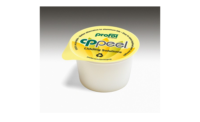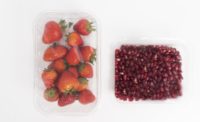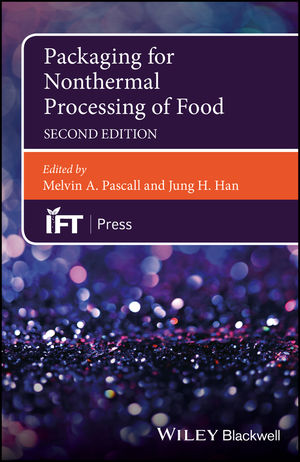The universe of flexible lidding applications is large and continues to expand. Flexible lidding is used for packaging an enormous variety of foods, as well as medical items, pharmaceuticals, health, beauty and personal care products, hardware, small electronic parts and much more. While flexible lidding materials include film, paper and foil, in this primer we’ll take a look at flexible lidding film for food applications, an area we think will continue to grow in the near and long term.
Choosing a lidding film is a complex process. Today’s CPG has many considerations: the type of seal, seal strength, oxygen- and moisture-barrier and anti-fog requirements for the application. There’s also film thickness, the ability to seal through overfill, the type of container, the backing substrate, the ingredients inside the packaging, shelf life, sealing equipment, compliance requirements and the application conditions. All of these elements must be understood fully in order to ensure that the proper film is selected for a successful application.
The converter has a myriad of considerations as well, and many overlap with those of the CPG. Besides the fundamental questions regarding film handling, we’re hearing more converters request downgauged films so that they can increase their efficiencies, reduce production costs and lower the weight of the final product. Many laminations used in the lidding market are constructed with a 12-micron PET laminated to a 35-micron or thicker, sealant web. The total thickness of the final structure is usually 50 microns or thicker. But now it’s possible to choose a 25-micron PET base film with a 12- to 20-micron sealant that is strong enough to handle a matrix rewind, as well as provide seals comparable to or stronger than a 35-micron sealant web. Thinner films translate into larger rolls and fewer changeovers.
New and Traditional Applications Create Opportunities
We’re optimistic about the lid stock market for several reasons. A significant driver of new business is people’s desire for single-size portions of healthy, artisanal and traditional snacks and foods in grab-and-go packaging that is easy to open. We also see strong interest from the vegetable market (another healthful consumer choice) among converters who want to replace the top of the traditional clamshell format with a clear lidding film. Another important trend we’re tracking is for resealable lidding film, which allows the consumer to open and reseal the package many times over. With the growth of online shopping for healthy consumables and meal kits, we’re seeing much more interest in lidding films that are solvent-free and do not risk imparting an odor to the food. Last, consumer demand for frozen and fresh entrees and side dishes shows no sign of slowing down.
Many companies are requesting lidding films that can seal through food overfill on the rim of the tray, which frequently appears during the fill process. Depending on the nature of the food, the process of sealing through it can range from easy to very difficult. Product managers are recognizing that having a lidding film that seals through overfill significantly reduces internal waste and forestalls consumer complaints.
Sealing: The Real Deal
There are two prevalent types of seals in the lidding market: peelable seals and weld seals. A peelable seal should allow the consumer to peel the film off the container easily without tearing or leaving any residue on the rim of the container. A weld seal fuses the lidding film to the container and cannot be peeled off. The trend today is toward the peelable seal, as it is much easier for the consumer to use. However, peelable seals present the challenge of creating a seal that is not only consumer-friendly (i.e., easy to peel without tearing when peeled and leaving no residual material on the tray flange), but also strong and secure enough to protect the contents inside the package, especially during distribution.
Some lidding films will seal to a variety of tray materials, while others will seal only to one type of material. Most food companies want one, universal lidding film that will seal to every type of tray. Specifying one film type makes the ordering and production process simpler. However, universal films are available only in a peelable version. EVA is one of the more commonly used polymers in the lidding industry because it can seal to most of the types of plastic containers used in today’s packaging. For weld seal applications, the sealant material will typically be of the same material as the container.
Choosing a robust film with advanced sealant technology is critical for making a successful lidding application that upholds brand integrity. Without a strong, secure, consistent bond that creates a hermetic seal, food is at risk of contamination and spillage. Robust sealant technology should not only seal through any overfill, but it should also “caulk” around overfill. Toray lidding films are constructed with a thin base PET film to which we apply a thicker, high-performance sealant coating that enhances the caulking functionality. Caulking also helps reduce manufacturing waste and the total cost of ownership. A high-performance sealant may also allow end users to replace multi-layer laminations, which are expensive. Expect a high-performance lidding film to also satisfy the food manufacturer’s desire for a robust narrow matrix rewind, which allows more lids to be produced and reduces downtime and waste during production.
Trays Today
Several types of trays are used in the lidding market: PP, CPET, APET, PS, HPDE, PVC, paperboard and aluminum foil. The application requirements will help determine what type of tray makes for the best fit. Some of the requirements are ovenability (whether for regular oven, microwave or both), barrier, clarity, strength and recyclability. PP trays are most commonly used in today’s packaging, as the majority of case-ready meats and dairy foods are packaged in PP containers, which are easily recycled. Those two markets account for more than half of the total food lidding market in North America.
Two increasingly popular applications – fresh and frozen side dishes and entrees that need to be heated – can also be packaged in a PP tray. Some manufacturers have already made the switch from traditional CPET trays to PP trays. There are three reasons for this change. First, PP trays are lighter than CPET trays, a characteristic that contributes to their being less expensive than CPET. Second, CPGs have discovered that most consumers do not heat their meals in a conventional oven. Rather, they prefer to microwave them, so there is no need for CPET, which is typically used for oven applications. Last, CPGs want to use less plastic as they strive to meet their sustainability goals. In addition, some PP trays are now mineral-filled with talc or calcium carbonate, which makes them an even greener option that is also less expensive. APET trays are used mostly in the produce industry, as they have excellent clarity, barrier and strength, but do not offer the heat resistance of CPET and PP trays. APET trays are typically coated with a de-nesting fluid because APET is a stickier polymer and the coating helps prevent the trays from adhering to one another after they are produced. Both the mineral-filled material in PP trays and de-nesting coatings greatly affect the sealability for lidding films, and it’s important to discuss those issues with the film supplier.
Other Considerations
Some of the other considerations when choosing a specific lidding film are its appearance and feel. Does it deliver a quality that is compatible with the brand’s image? Does it need to be printed and send a brand message? Are there options for white, metallized and clear versions? Which is preferable? Does the film need to be Interstate Milk Shippers certified? Are FDA compliance or Drug Master Film approvals required for medical applications? Then, there are sustainability questions. We touched on downgauging for a lighter final product that is more cost-effective overall. Are solvents used in the manufacture of the film? Would it be preferable to use a solvent-free film that is more environmentally friendly and does not impart any odor in the food product? Is a bio-based version available? Is the film recyclable?
Raising all of the considerations and questions covered here should help when entering into a dialogue about choosing a lidding film.
|
Lidding Film and E-Commerce E-commerce offers an excellent opportunity for growth in the lidding film market. Millions of Americans have shifted happily to online shopping and more people are exercising that preference every day. Also increasingly popular among consumers is meal kit delivery, something that people find not only convenient, but also a fun, creative way to prepare a meal. |






